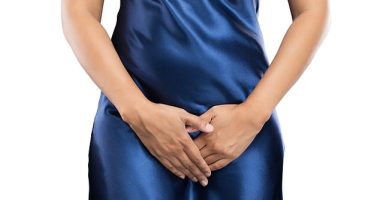Picking up her sixth prescription of antibiotics for a urinary tract infection (UTI) in ten months, Kate Elgood was at her wit’s end.
She’d been caught in a seemingly endless cycle of UTIs, being treated with antibiotics and then experiencing unpleasant bouts of thrush due to the antibiotics. That’s because, as well as wiping out harmful bacteria, antibiotics kill off the good bacteria in the vagina — these help maintain a slightly acidic environment, keeping microbes such as the candida fungus, which causes thrush, in check.
Most of us are by now familiar with the gut microbiome, the community of bacteria, fungi and viruses that are linked to the health of our digestive system, and beyond.
But less well known is that we have other important microbiomes around the body, including in the respiratory system, on our skin and in the vagina.
Men also have microbiomes in their semen and male genital tract.


Kate Elgood, a 44-year-old illustrator from Norwich, started to experience UTIs — caused when bacteria enter the urethra — aged 40
It’s only in recent years that experts have started learning more about the micro-organisms living in the vagina — and what happens when the delicate balance of good and bad bacteria goes out of kilter.
‘Lots of people, including medics and women themselves, aren’t aware of the importance of the vaginal microbiome,’ says Dr Jo Bailey, a consultant gynaecologist at University Hospitals Bristol NHS Foundation Trust.
The close proximity of the back passage, vagina and urethra (which allows urine to exit the body) means bacteria and other microbes can easily travel between them and cause disease — ‘the vaginal microbiome is a protective mechanism to reduce this’, she says.
But any reduction in the beneficial bacteria in that community can allow bad bacteria and other microbes to proliferate.
Kate, a 44-year-old illustrator from Norwich, started to experience UTIs — caused when bacteria enter the urethra — aged 40.
‘I had nearly a year of hell,’ she says. ‘The infections made me feel really unwell — I was passing blood, had a fever and sometimes I’d be sick. Each time I was given antibiotics and the UTI would clear up, then I’d develop thrush and need creams to treat it. And a few months later, the cycle started again — it was horrific.
‘I had to take time off work, intimacy was difficult and I was forced to stop my daily run, which I loved, because it would cause sharp pains in my pelvic area.
‘I felt let down by my doctors who couldn’t understand why I was getting so many UTIs and bouts of thrush, and made me feel I was dirty for having them.’
Kate turned to a private physiotherapist specialising in women’s health, as the UTIs had caused pelvic pain because her pelvic floor muscle had become permanently tense from the constant feeling of holding urine in.
She also saw a nutritional therapist, who told her about the vaginal microbiome.
‘I started taking a probiotic designed for the vagina, which differs completely from the probiotics for the gut; as well as one for the gut to counter the effect of the antibiotics,’ says Kate, who has a son, Max, nine, with her partner Ben, 44, a restaurant manager.
‘On the nutritional therapist’s advice, I cut out sugar, refined carbohydrates and alcohol and introduced more leafy greens.’
She’s not had a UTI — or thrush — since.
She believes her UTIs were linked to hormonal changes related to the perimenopause (the stage before the menopause).
Oestrogen, which starts falling when women enter the perimenopause, is vital to maintaining healthy levels of ‘good’ Lactobacilli bacteria in the vagina, explains Dr Paula Briggs, a consultant in sexual and reproductive health at Liverpool Women’s NHS Foundation Trust.
‘Oestrogen creates glycogen, which is excreted by the vaginal walls, and which feeds the strains of Lactobacilli. But without oestrogen, you reduce the volume of the healthy bacteria and then bad bacteria can become more abundant.’
Lactobacilli produce lactic acid, lowering the pH in the vagina to a slightly acidic level (it should be between pH 3.8 and 4.5). Without it, the environment can become more neutral, allowing infections such as thrush and bacterial vaginosis (BV) to thrive.


Claire Hattrick, 56, a mother of two from Andover, Hants, developed BV after the menopause. Around four years ago she started experiencing excess watery discharge and, after taking a swab, her GP diagnosed BV and prescribed antibiotics
BV, which affects 30 to 50 per cent of women at some point, can occur when there is an overgrowth of ‘bad’ bacteria — such as Gardnerella, Staphylococcus, Streptococcus and E. coli.
‘Everybody’s got those organisms but most of the time they’re not growing in an out-of-control way,’ explains Dr Briggs, who is also the chair of the British Menopause Society.
Symptoms include itching, soreness, vaginal discharge and odour; the infection is also linked to an increased risk of preterm labour and late miscarriage.
(An imbalance in the vaginal microbiome increases the risk of pelvic inflammatory disease, an infection of the ovaries, fallopian tubes and uterus which is often caused by bacteria spreading from the vagina — left untreated, it can affect fertility.)
Claire Hattrick, 56, a mother of two from Andover, Hants, developed BV after the menopause. Around four years ago she started experiencing excess watery discharge and, after taking a swab, her GP diagnosed BV and prescribed antibiotics.
‘It took a long time to go and then it returned eight months later, and again about a year after that — it really started to get me down,’ says Claire.
‘I was being offered three months of antibiotics at a time and I was concerned about taking them for so long and they didn’t help anyway — so I was given an antibiotic cream to use vaginally, which worked slightly better.
‘Then I did my own research and came across probiotics aimed at improving the vaginal microbiome,’ explains Claire, who runs the Executive Menopause Coach company.
‘They’ve been a game-changer — since I started taking them two years ago I haven’t had BV.’
While antibiotics can be effective, they don’t work for everyone. ‘I see women in clinic who’ve had thrush or BV and have tried everything out there and it’s been frustrating when I don’t have anything else to offer if antibiotics aren’t the answer,’ says Dr Bailey.
‘More than half of women treated with antibiotics for BV have a recurrence within six months.’
But could taking probiotics aimed specifically at improving the balance of bacteria in the vagina help? Like those given to boost gut health, they are usually taken in tablet or capsule form.
‘Some women with vaginal symptoms say they’ve tried probiotics, but they’ve been taking ones targeted for the gut and don’t contain the Lactobacilli which are good for the vagina,’ says Dr Bailey, who’s been involved in developing a vaginal probiotic for VJJ Health.
A study published last year, in the journal Beneficial Microbes, looked at the impact of probiotics containing one of the key strains of Lactobacilli, Lactobacillus crispatus, on 93 women with thrush and 89 with BV. The women were given a probiotic or placebo capsule during a three-month period.
The results showed that after four weeks the women who had thrush or BV who were taking the probiotic reported a reduction in their symptoms, whereas the placebo group did not — furthermore, swabs indicated that the BV patients’ bacteria levels were almost back to normal, reported the independent study which was part-funded by the Estonian Research Council.
However, some experts remain cautious about vaginal probiotics, especially when declining oestrogen levels are likely to be causing problems.
‘My feeling is that you first treat the underlying cause — i.e. a lack of oestrogen — as I don’t think there’s strong enough evidence to show probiotics work,’ says Dr Briggs.
Dr Laura Goodfellow, an academic clinical lecturer at the Centre for Women’s Health Research at Liverpool University, adds: ‘My worry with these products is that if you don’t know what your baseline is (i.e. how healthy your microbiome is), you could be changing something that’s actually fine.
‘I don’t think there’s enough research yet to recommend them to everyone. But for women at the end of their tether with BV, for example, where conventional treatments aren’t working, then it’s not unreasonable to try them.’
Yoghurt has traditionally been used as a home remedy to improve the balance of bacteria in the vagina — a small study in 1993 involving 32 pregnant women with BV found that using yoghurt inserted with a tampon treated the condition, reported researchers at Beilinson Medical Center in Israel.
‘Trying this method would be soothing for symptoms because the bacteria within yoghurt would help to restore the balance of the vaginal microbiome, and it would definitely not do any harm,’ says Dr Briggs. While some makes of yoghurt contain certain strains of Lactobacillus, it doesn’t contain the strains associated with optimum vaginal health, such as Lactobacillus crispatus.
Additionally, a 2018 study in the journal Beneficial Microbes suggested that yoghurt drinks containing Lactobacillus strains (crispatus, jensenii, gasseri and rhamnosus) could improve the recovery time and symptoms of BV.
Sometimes it isn’t clear when the vaginal microbiome is out of balance, as women don’t always have obvious symptoms — but experts believe that pH tests could provide insight into what’s going on.
‘If you have a reduction in healthy vaginal bacteria then the pH goes up,’ says Dr Briggs
‘Testing the pH is fantastic but it’s not used widely by clinicians due to a lack of awareness.’
Meanwhile, there are steps women can take to reduce the risk of undermining the balance of the vaginal microbiome.
‘Cotton underwear is preferable, and diet can also make a difference; highly processed food, sugar and refined carbohydrates are thought to disrupt the gut microbiome and encourage “bad” bacteria,’ says Kate Waters, a nutritional therapist who specialises in intimate health.
Smoking can disrupt the vaginal microbiome — it’s not entirely clear how but it may be because nicotine reduces levels of Lactobacilli. Unprotected sex may have an effect, as semen is alkaline and temporarily raises the pH of the vagina, potentially allowing unfriendly bacteria to dominate.
But don’t assume ‘cleaning’ is the answer.
‘Douching [when women wash inside the vagina itself with soap] and using perfumed soaps, scented loo roll, intimate sprays and scented sanitary products can all disrupt the delicate balance in there and is not advised — it’s best just to use water on the vulva and surrounding area,’ explains Dr Goodfellow.
Source: Mail Online









